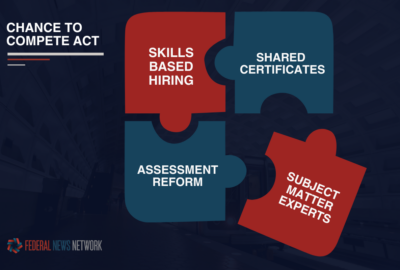Heading into 2024, OPM ‘fundamentally rethinking’ federal hiring
For the Office of Personnel Management, even more plans appear to lie ahead. But many may come in smaller bites and require leadership from chief human capital...
The Office of Personnel Management had a busy year, managing to push out plenty of proposed regulations during 2023 that aim to reform federal hiring and improve workforce challenges.
Even more plans and changes appear to lie ahead, though many may come in smaller bites, and require leadership from chief human capital officers (CHCOs) and other workforce experts in government.
“We are fundamentally rethinking hiring in government,” OPM Director Kiran Ahuja said during a Dec. 12 CHCO Council meeting. “Our big focus has been on utilizing pooled hiring, where multiple agencies with the same need can take advantage of one hiring action … It is so incredible of a tool that we have at our disposal right now.”
Pooled hiring lets agencies streamline the federal recruitment process by onboarding multiple job candidates from a single job announcement. The strategy for agencies has recently worked well, with one key example being thousands of feds hired to work on the Infrastructure Investment and Jobs Act. Last year, agencies shared six broad hiring actions.
For 2024, OPM’s focus appears to be shifting even more toward pooled hiring. Jason Miller, the Office of Management and Budget’s deputy director for management, has already said there are plans for at least eight pooled hiring actions governmentwide over the next year.
And the stage is already set for those future actions. In December, OPM launched a pooled hiring platform on USAJobs to try to streamline the process of sharing certificates for agencies that are recruiting for the same type of jobs. There are already posts looking to hire IT program managers, IT specialists and data scientists governmentwide.
But to achieve the increases in these federal hiring strategies, improving and supporting federal human resources (HR) work will be crucial.
“The best way to onboard talent fast is to strengthen the HR workforce,” Ahuja said.
Agencies managed to hire more than 80 HR specialists across government using just one job announcement — a strategy that OPM aims to repeat and bring to scale during 2024.
“Through a really strong partnership between OPM and the CHCO Council members, we worked to design and pilot HR workforce career path models, compile HR workforce training and career pathing resources that we have all across the federal government, and we’re developing a long-term vision for an HR professional development framework,” Ahuja said.
In its fiscal 2024 budget proposal, OPM included funding for a senior leadership position at OPM dedicated to workforce planning for federal HR professionals.
“This is such critical work,” Ahuja said. “And it’s only possible through the incredible partnership and leadership that we have in the CHCO Council.”
Are the reforms “too little, too slow”?
Despite solid progress, some federal workforce experts are concerned that time is running short to carry out many of the Biden administration’s ideas, as 2024 is the final year of the administration’s first term.
“Many of these administrative reforms could have been implemented in year one or two of the Biden administration,” said Ronald Sanders, a federal workforce expert and former chairman of the Federal Salary Council. “The fact that OPM still has not introduced any major civil service reform legislation is especially troubling. In that regard, I fear that while they have the right idea, these various efforts are too late in this term to have a lasting effect.”
“The Biden administration is doing far too little, too slow, to advance and improve federal HR and address longstanding federal management challenges,” Jason Briefel, partner and director of government and public affairs at Shaw Bransford & Roth, said in an email. “Will the executive branch be able to make any more meaningful progress before it is too late? Is the federal HR system already broken beyond repair, with too little will and resources to really do what needs to be done?”
The future of many of these reforms remains tied up in Congress as well. For one, the Chance to Compete Act would overhaul hiring processes by setting more requirements for agencies to share certificates, use technical assessments, involve subject matter experts (SMEs) — and more.
“We are following multiple bills like the Chance to Compete Act,” Jenny Mattingley, vice president of government affairs at the Partnership for Public Service, said in an email. “It focuses on hiring and garnered large bipartisan support [and] may still drive conversation about skills-based hiring and the use of assessments.”
But with ongoing funding uncertainty for both OPM and the rest of the government, these reforms may be more difficult to accomplish, especially going into an election year. The Chance to Compete Act passed the House 422 to 2 in January 2023, but the bill’s future is still up in the air.
“With divided government and the House mired in dysfunction, there was not significant action on legislative reforms for the federal workforce, even as the Chance to Compete Act looks to bolster trends in federal hiring,” John Hatton, a staff vice president at the National Active and Retired Federal Employees Association (NARFE) said in an email.
And while the Biden administration has made progress through the President’s Management Agenda to track hiring-related data more effectively, Hatton said the data has indicated some negative results.
“Hiring manager satisfaction has been trending downward since 2021, and agencies continue to rely primarily on self-assessment questionnaires to screen applicants,” he said.
The future of Schedule F
One other notable federal workforce issue that may underpin much of 2024 is the ongoing debate over Schedule F. The now-revoked executive order sought to reclassify federal employees in some policy-related positions, making them at-will and easier to fire.
Proponents of the order said it was an effort to add accountability to the career civil service and give agencies more flexibility to fire poor performers. But the executive order quickly gained pushback from federal unions, organizations and broad swaths of employees. Many called it a thinly veiled attempt to politicize the federal workforce.
“This is nothing less than a return to the ‘spoils system’ that we abandoned over a century ago,” said Sanders, who resigned from his position in 2020 in response to Schedule F. “If it comes to pass, it will truly undo merit principles as the underpinning of the federal workforce.”
OPM proposed regulations in September seeking to clarify and reinforce workforce protections, and serve as a guard against the possible return of Schedule F in the future. OPM plans to finalize the regulations this coming spring, but some experts have said the new regulations would only serve as a speed bump, rather than a full block, of Schedule F.
Regardless, OPM still has a heap of other work ahead in the last year of the Biden administration’s first term — and much of it focuses on the hiring side of the equation.
“If you’re taking nothing else away from what I’m saying,” Ahuja said to CHCOs in December, “Pooled hiring actions, pooled hiring actions, pooled hiring actions.”
Copyright © 2025 Federal News Network. All rights reserved. This website is not intended for users located within the European Economic Area.
Drew Friedman is a workforce, pay and benefits reporter for Federal News Network.
Follow @dfriedmanWFED






